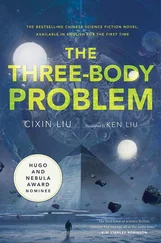The fleet command system had just stabilized itself, only to be plunged once again into chaos. This time, its despair over the loss of every weapon available to it meant it would not recover from this collapse.
The merciless slaughter in space continued. As the distance between ships grew, the droplet accelerated and had soon doubled its speed to sixty kilometers per second. Exhibiting a cool and precise intelligence in its continuous attacks, it solved the traveling salesman problem in local regions with perfect accuracy, hardly ever retracing its path. With its targets in constant motion, the droplet accomplished a huge range of accurate measurements and complex calculations effortlessly and at high speed. In the course of its intensely focused massacre, it would occasionally veer off to the edges of the group of ships to quickly dispatch a few outliers and arrest the fleet’s inclination to flee in that direction.
The droplet usually made precise strikes on the ships’ fuel tanks—whether it found them by real-time location detection or with the use of a stored database of every ship’s structure provided by the sophons was unknown. However, in around 10 percent of the targets, the droplet did not strike the tanks. The destruction of those ships did not involve fusion in the nuclear material, so it took a comparatively long time for the red-hot ships to finally explode, a brutal situation in which the crew suffered under high temperatures before burning to death.
The evacuation of the ships did not go smoothly. It was too late to enter deep-sea state, so the warships could only evacuate at Ahead Three acceleration, which made scattering impossible. Like a sheepdog racing alongside a flock, the droplet executed occasional blocking strikes at different positions at the fleet’s edges to keep it in shape.
Space was full of cooled or still-molten debris and large chunks of warships, so ship defense systems had to continually sweep their flight path with lasers or railguns. The fragments formed glittering, flaming arcs that wrapped each ship in a brilliant canopy. Yet some debris still slipped through the defenses and caused serious hull damage and even loss of navigational capability when they struck the ships directly. Collision with larger fragments was fatal.
Despite the collapse of the fleet command system, High Command remained in charge during evacuation, but the density of the initial formation meant collisions between ships were unavoidable. Himalaya and Thor collided head-on at high speed and were smashed to bits. Messenger rear-ended Genesis, and the air that leaked like a hurricane through the gashes tore into both ships and blew personnel and other objects out into space, forming tails that dragged along in the wake of the two giant wrecks.
Most horrifying of all was what happened to Einstein and Xia, whose captains bypassed system protections via remote control mode and entered Ahead Four acceleration. None of their personnel was protected by deep-sea state. Images transmitted from Xia showed a hangar emptied of fighters but occupied by over a hundred people who were flattened against the deck by the high g s once acceleration began. From this vantage point, observers saw crimson flowers of blood bloom on the white space the size of a football field, forming extremely thin layers that spread out and ultimately merged into one under the immense force…. Spherical cabins presented the ultimate horror: At the beginning of hypergravitation everyone inside slid to the bottom, and then the devil’s weighty hand squished them all into a lump, as if balling up a pile of clay men, with no time for anyone to even scream. The only sound was of shattering bones and viscera squeezing out. Then the pile of flesh and bones was submerged in a bloody liquid that turned eerily clear once the solids were precipitated out by the high g s, its surface flat and motionless as a mirror under the intense force. It seemed solid, and the formless pile of flesh, bone, and organs lay within it like rubies sealed in crystal….
Afterward, people initially thought that putting Einstein and Xia into Ahead Four had been a mistake made during the chaos, but further analysis repudiated this view. Using the remote control mode to bypass the stringent procedures required by the warship control system prior to executing Ahead Four acceleration, including the confirmation that all personnel were in deep-sea state, involved a complicated series of operations that were unlikely to have been made in error. In the information transmitted from the two ships, it was also found that, prior to entering Ahead Four, Einstein and Xia had been using fighters and smaller craft to transport personnel outside. They did not enter Ahead Four until the droplet drew nearer and neighboring warships began to explode. This suggested that they intended to escape the droplet at top acceleration to preserve humanity’s warships, but even Einstein and Xia were unable to evade the droplet’s clutches. The keen-eyed death god noticed that two ships were accelerating far faster than the average rate of the group and swiftly caught up to them and destroyed the ships and their lifeless cargo.
But two other warships successfully accelerated at Ahead Four and escaped the droplet’s attack: Quantum and Bronze Age, which had both entered deep-sea state prior to the battle, at Ding Yi’s behest. As soon as the third row of ships had been destroyed, the two of them entered Ahead Four and made an emergency escape in the same direction. Their position in a corner of the array, with the entire fleet separating them from the droplet, gave them sufficient time to escape into the depths of space.
More than a thousand ships, over half the fleet, had been destroyed in a twenty-minute attack.
Space was chock-full of debris in a cluster ten thousand kilometers in diameter, a rapidly expanding metallic cloud whose edges were illuminated time and again by the nuclear fireballs of exploding warships, as if a giant, stony face were flickering in and out of the cosmic night. In between the fireballs, the glow of metallic magma turned the cloud into a blood-red sunset.
The remaining warships were scattered widely, but nearly all of them were still within the metallic cloud. The majority had exhausted their railguns and had to rely on lasers to open up a path through the cloud, but the energy drain made the lasers underpowered and left the ships to wend a slow, torturous path through the debris. Most of them moved at a speed practically the same as the cloud’s rate of expansion, turning it into a death trap from which evacuation and flight were impossible.
The droplet’s speed was now ten times the third cosmic velocity, or roughly 170 kilometers per second. Its course took it smashing through debris that liquefied under impact, splashing away at high speed to collide with other debris and giving the droplet a brilliant tail. First it resembled a comet bristling with rage, but as the tail lengthened, it turned into a huge silver dragon that stretched ten thousand kilometers. The entire metallic cloud glowed with the dragon’s light as it whipped to and fro in its mad dance. The warships penetrated by the dragon’s head began to explode along its body, so that it was dotted with the nuclear explosions of four or five small suns at any given time. Further back, molten battleships became million-ton metallic magma explosions that dyed its tail a bewitching bloodred….
The brilliant dragon was still flying thirty minutes later, but the nuclear fireballs on its body had disappeared, and its tail was no longer bloodred. Not a single warship remained in the metallic cloud.
When the dragon flew out of the cloud, its body vanished at the cloud’s edge, its head followed by its tail. Then it began taking out the remnants of the fleet. Only twenty-one warships had cleared the cloud, most of them suffering enough damage in the process that they retained minimal acceleration or were even coasting unpowered. These were quickly caught and destroyed by the droplet. The metallic clouds formed from the newly exploded ships expanded and merged into the larger cloud.
Читать дальше












